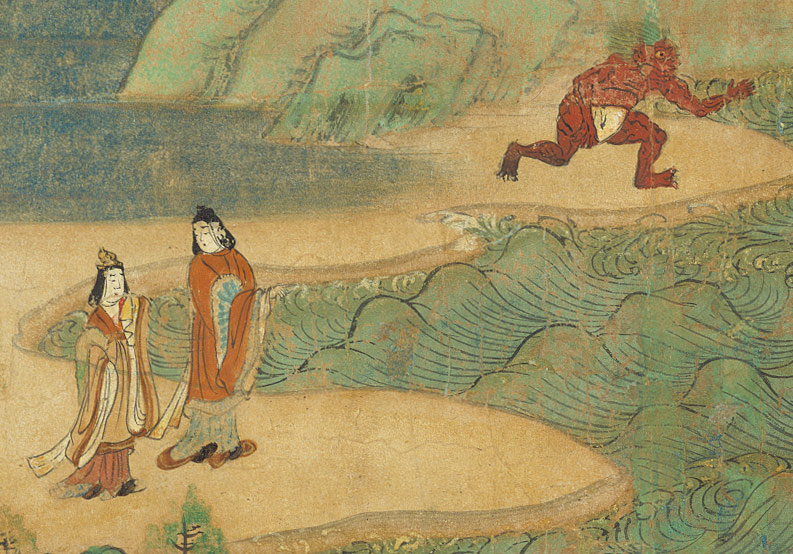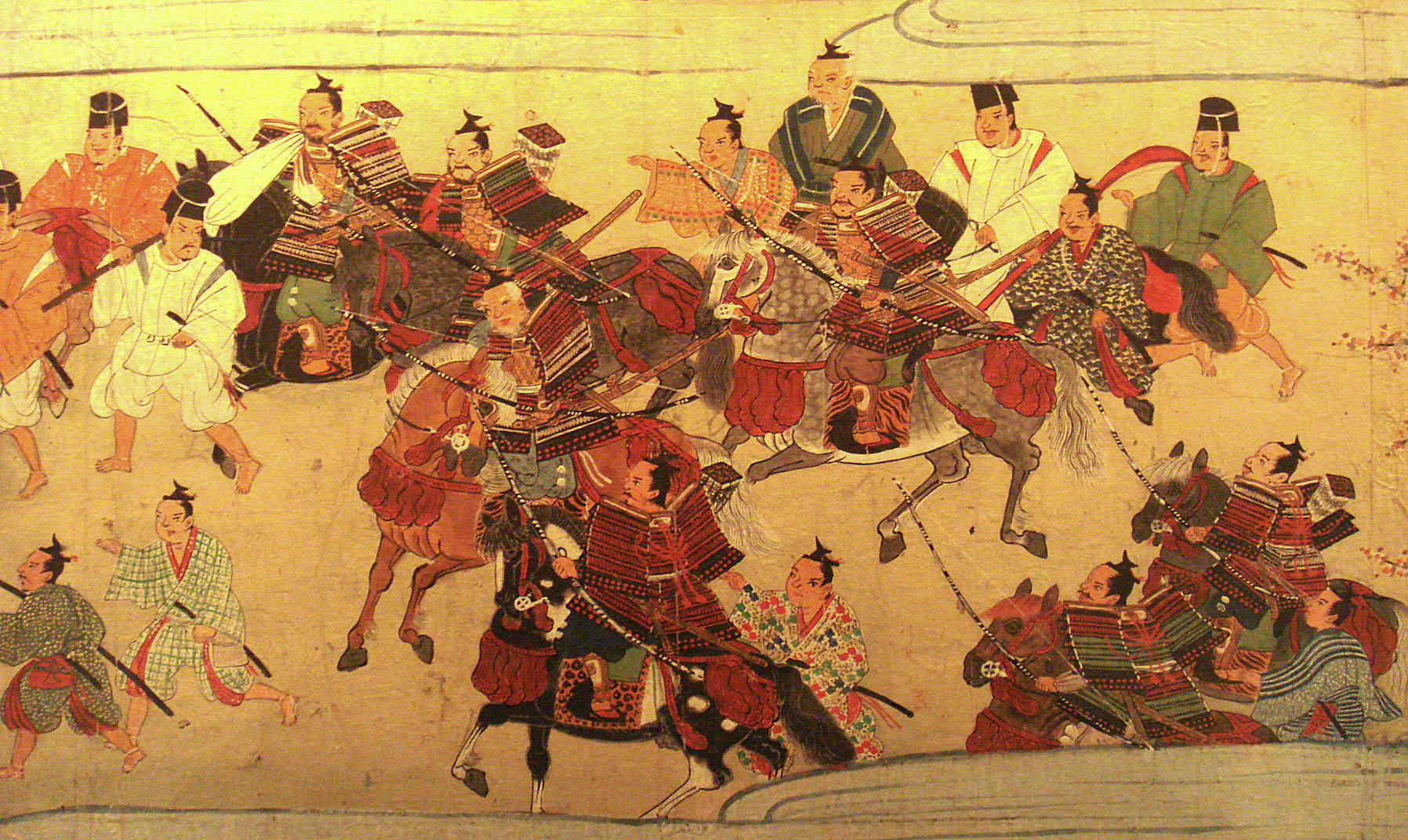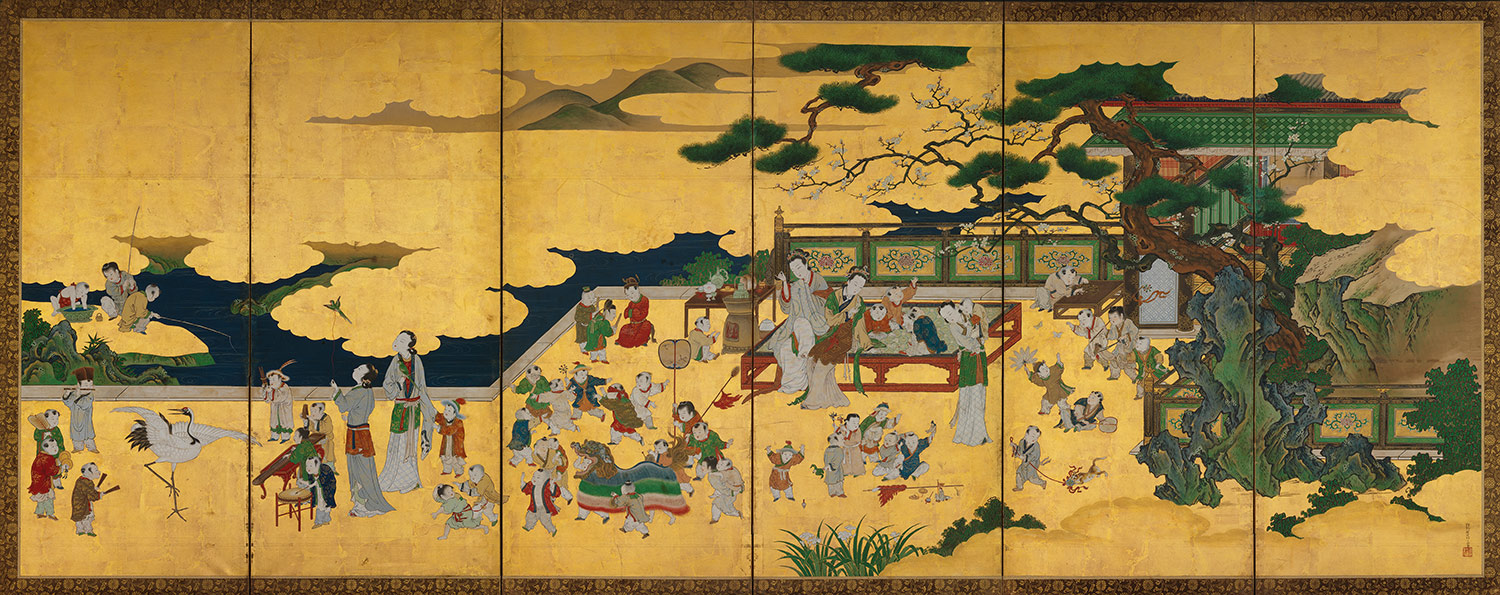Historical Development Period (~Undefined- 221BC)
Early Chinese Art dates back to the Neolithic Yangshao culture, in the 6th millenium BC. The Yangshao made pottery- early ceramics were unpainted at first, but soon evolved with fish and human faces, and abstract designs. The Bronze Age began with the Xia dynasty, which created more elaborate objects. Bronze vessels were receptacles for storage of food and water. The most recognizable of these objects was the Ding, shown below. It is typical of the Shang style that required all available space to be developed, oftentimes with forms of real and mythological animals.Unknown Ding Sculptor:
Early Imperial Chinese Art (~221BC- 220AD)
Three very cool results from early imperial China include the Qin Sculptures, development of pottery, and Han Art. The terracotta army, inside the tomb of the first Qin Emperor, consists of over 7,000 life-size tomb terra-cotta figures of warriors and horses. These figures were originally painted, but are today worn by time. Each figure's head is unique, and is a good instance of the development of facial features in sculptures. Unknown Craftsmen:
The most famous type of pottery from China is porcelain, which is made form a hard paste of kaolin (a clay) and a feldspar calledd pentuntse, which cements vessels and seals pores. The notable difference between porcelain and other pottery clays is that it wets very quickly. Water has a greater effect on the plasticity of porcelain than other clays. It tends to move longer than other clays, which means a higher skillcap was required of the sculptor to handle the material. As such, porcelain was very expensive and in high demand. Unknown Sculptor:
Finally, Han art. The Han Dynasty was famous for Jade Burial suits. One of the earliest known depictions of a landscape in Chinese art comes from a pair of door panels from a tomb near Zhengzhou, dated 60 BC. The landscape was made by the repeated impression of standard stamps on the clay while it was soft. Han Dynasty State Artist:

Division period (~220AD- 581AD)
The advent of Buddhism was most prominent around the first century AD, and China soon incorporated these traits into artistic expression.The style was majestic, solemn, and distanced itself from the Buddhist theme of accessible enlightenment. This progressively led towards more naturalism and realism, and culminated in the expression of Tang Buddhist Art. In ancient China, painting and calligraphy were the most highly appreciated arts in court circles and were produced exclusively by those who had the time to perfect technique and patience needed for the brushwork. Considered the purest form of painting, it was done with a brush pen of animal hair, and black inks of pine soot and animal glue. Some famous calligraphers of the time include Wang Xizhi, whose art is below.Sui- Tang Dynasties (~581AD-960AD)
Buddhist sculpture underneath the Tang dynasty evolved towards lifelike expression. As a consequence of the dynasty's open trade policies through the Silk road, the Tang Dynasty adopted a rather classical form of Buddhist sculpture. However, by the end of the Tang dynasty, foreign influence began getting rejected. The emperor of the time, Wu-Tsung, ordered art of the faith to be destroyed, which was a setback to art's development in China. Beginning in the Tang Dynasty, the primary method became painting. In these landscapes, usually monochromatic and sparse, the purpose was not to reproduce exactly the appearance of nature but rather to grasp an emotion or atmosphere so as to catch the "rhythm" of nature. Painting in the traditional style involved essentially the same techniques as calligraphy and was done with a brush dipped in black or colored ink; oils were not used. As with calligraphy, the most popular materials on which paintings were made were paper and silk. The finished works were then mounted on scrolls. A painting reminiscent of this style is shown below, done by a famous calligrapher named Dong Yuan, titled "Mountain Hall."
Song and Yuan Dynasties (~960- 1368)
The Song dynasty featured more subtle landscapes, where immeasurable distances were conveyed through blurred outlines, mountain countours retreating into mist, and impressionistic treatment of natural phenomena. Zhang Zeduan was a notable painter for his piece, "Along the River During Qingming Festival," displayed below. It has been quoted as "China's Mona Lisa," and has many known remakes throughout history.
The Yuan dynasty came about with the fall of the Song to Mongol conquerors. Most court and literary artists retreated from social life and returned to nature through landscapes.
Late Imperial China (~1368-1911)
Under the following Ming dynasty, Chinese culture bloomed. Narrative painting, with wider color range and busier composition than most other periods. Schools were developed for art, which popularized painting, and European culture began to make an impact on Chinese art during this period. Two schools of thought dominated the early Qing Dynasty, after the Ming. The first was the Orthodox school, which sought to recreate past styles and focused on technical skills in brushstrokes. The second were the Individualists, which as the name might imply, focused more on individual style. The Shanghai school presented a middle ground, paying homage to ancient technique while maintaining an individualist perspective in terms of Chinese modernization and documenting rapid social change. Below demonstrates the Orthodox School, a painting from 1664 by the Qing Dynasty Painter, Kun Can. Under the following Ming dynasty, Chinese culture bloomed. Narrative painting, with wider color range and busier composition than most other periods. Schools were developed for art, which popularized painting, and European culture began to make an impact on Chinese art during this period. Two schools of thought dominated the early Qing Dynasty, after the Ming. The first was the Orthodox school, which sought to recreate past styles and focused on technical skills in brushstrokes. The second were the Individualists, which as the name might imply, focused more on individual style. The Shanghai school presented a middle ground, paying homage to ancient technique while maintaining an individualist perspective in terms of Chinese modernization and documenting rapid social change.
New China (~1912-1949)
With the end of the last dynasty in China, the New Culture Movement wanted Chinese culture to modernize and reflect the new China. The Chinese Civil War caused drastic splits between the Kuomintang and the CCP, and art went to a standstill around the time of conflict. Zhang Leping's Sanmao: A well known comic book character in China.
Communist and Socialist Art (~1950-1985)
The Communist Party of China gained full control of the government with Mao Zedong heading the PRC. Artists were promoted if they promoted the government, and vice versa, clash with communist beliefs would force artists into agriculture via reeducation processes underneath the regime. Government control's peak came during the Cultural revolution, which contained the Destruction of the Four Olds, which had major consequences for pottery, paintings, literary art, and countless other forms.Rebuilding (~1985-Present)
Contemporary Art, oftentimes referred to as Chinese Avant-garde, continued to develop during the 1980s when government control loosened and modern art developments began to spring up. New aspects of the visual arts in such a massive topic can be found in more detailed websites. Let's move to Japanese art.Jomon (~11000BC- 300BC)
The Jomon were nomadic hunter gatherers who decorated pottery and created clay figurines called dogu, embedded with crystal jewels. Below: "Statuette with Snow Glasses," from the Jamon Era.
Yayoi (~350BC)
The next wave of immigrants, the Yayoi, brought knowledge of copper weapons, bronze bells, and kiln fired ceramics.Kofun (~250AD-552AD)
The Kofun period is a modification of Yayoi culture, named for the megalithic tombs created during the period. Typical artifacts found include bronze mirrors, symbols of political alliances, and clay sculptures called haniwa which were erected outside, you guessed it, tombs. Below is titled "Haniwa Figure of a Shamaness," done in the 5th to 6th century. This piece represents a Shinto Priestess who would have presided over a funeral ceremony of a chieftain.
Asuka/Nara (~552-784)
During this era, the transmission of Buddhism provided initial impetus for artistic changes. Facets of Chinese culture, including writing and new artistic technologies, made their appearance in Japanese culture. Typical art pieces of this period include sculptures of the Buddha, which are dated back to the 6th century. They are characterized by realistic rendering and flowery patterns. Unknown Sculptor:Heian (~794-1185)
The Heian period further emphasized worship, which manifested itself in the architecture and early styles of painting, including Yamato-e and e-maki (the picture scroll). The e-maki was a system of pictorial conventions that visually conveyed emotional content. This style was seen in both men and women's pictures. Between genders, the art style remains similar, but the distinction lies in the subject matter being portrayed. Female artists were most concerned with court life and romantic themes, stark contrast to the Men's more violent preferences. Below is an example of this: Chigusa Kontani's "Lady in Heian Court."
Kamakura (~1180-1338)
This period was characterized by a shift of power from the nobility to the warrior class. The arts had to satisfy a new audience: men devoted to warm priests committed to Buddhism, and conservatives. Realism became a popular trend, reviving different types of sculptures and introducing calligraphy and painting. Unidentified Kamakura Artist:
Muromachi (~1338-1578)
Another profound change happened in this time period. The Ashikaga clan took control of the shogunate and moved headquarters. With the overnment's return, cultural expression took a more aristocratic and elitist character. Because of secular trading from Zen temples in China, many Chinese works ofart were imported into Japan and profoundly influenced Japanese artists working for the shogunate. This changed the subject matter and the color used to paint. The bright colors of Yamato-e yielded to monochromatic black and white, as was popular in China. Unknown Artist:
Azuchi Momoyamo (~1573-1603)
This period gave birth to the most important school of painting in Japan, the Kano school, and the greatest innovation of the period was the creation of landscapes on sliding doors surrounding a room.Edo Period (~1603-1867)
The Tokugawa Shogunate gained undisputed control in 1603 with a commitment to bring peace and political stablity to the country. It was successful in doing so until Western nations began pressuring the country to open for trade. One of the dominant themes of the Edo period was the repressive policy of the shogunate and the attempts of artists to escape those structures. The country was closed to foreigners. Painting at the time floruished regardless, with the development of Sotatsu, which was recreation of themes from classical literature, with brilliantly colored backgrounds. The Schools of Art, Ukiyo-e and Bunjinga, created ukiyo-e paintings and woodblock prints of the domimonde. In the 19th century, the dominant figures were Hokusai and Hiroshige, who had profound impacts on oainting and chose to depict figures from life outside the structure of the shogunate. Below is titled "One Hundred Boys," a piece from Kano Eino, taken from the 17th century.
Prewar (~1868-1930)
During the Prewar Period, the introduction of Western cultural values led to an interesting dichotomy in Japanese art, with clashes between traditional art and attempts to duplicate and assimilate a variety of incoming foreign ideas. The first response to Western art forms was open hearted acceptance, which was evident with the opening of several western art schools. The second, and more vehement response was in the opposite direction, lead by Okakura Kakuzo and Ernest Fenollosa, who encouraged artists to retain traditional themes and techniques while adapting to the modern world.Postwar (~1945-Present)
After World War 2, many artists began working on art forms derived from the international scene. But traditional conceptions still endured, in particular a propensity for certain light combinations (bright). Postwar art reflected a willing change in the priorities of the Japanese people, hence an avant-garde movement and the development to the fields of entertainment. Cartoons led to anime that at first were derived only from manga sotires, but today, artists and studios create animation and art in the traditional manner with new mediums like television. Below is titled "Samurai, the Watcher," a piece by Koichi Tateishi.